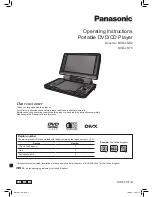
25
English
JPEG:
(Joint Photographic Experts Group)
JPEG is a method of compressing
still image files. You can copy JPEG
files on CD-RW / R or DVD+R / RW
discs from a computer and play back
the files on this unit.
MP3:
(MPEG Audio Layer 3)
MP3 is a method of compressing
files. You can copy MP3 files on CD-
RW / R or DVD+R / RW discs from a
computer and play back the files on
this unit.
Multichannel:
DVD is specified to have each sound
track constitute one sound field.
Multichannel refers to a structure of
sound tracks having three or more
channels.
Parental control:
A function of the DVD to limit playback
of the disc by the age of the users
according to the limitation level in
each country. The limitation varies
from disc to disc; when it is activated,
playback will be prohibited if the
software’s level is higher than the
user-set level.
PBC (Video CD only)
:
(Playback Control)
This function enables you to play back
interactive software using a menu
screen. See also Title.
PCM
:
(Pulse Code Modulation)
PCM is a format that converts audio
into digital data. It is mainly used for
Audio CDs and DAT. This unit can play
back sounds as realistic as possible
by converting even compressed Dolby
Digital and MPEG audio to PCM.
Region code:
Regions associate discs and players
with particular areas of the world. This
unit will only play back discs that have
compatible region codes. You can
find the region code of your unit by
looking on the rear panel. Some discs
are compatible with more than one
region (or all regions).
Sampling frequency:
The rate at which sound is measured
by a specified interval to turn it into
digital audio data. The number of
samples in one second is defined as
the sampling frequency. The higher the
rate is, the better the possible sound
quality.
Glossary
Analogue audio:
An electrical signal that directly
represents sound. In contrast, digital
audio can also be an electrical signal,
but is an indirect representation of
sound. See also Digital audio.
Aspect ratio:
The width of a TV screen relative to
it is height. Conventional TVs are 4:3
(i.e., the screen is almost square).
Widescreen models are 16:9 (the
screen is almost twice as wide as its
height)
AUDIO OUT jacks:
Jacks on the back of the DVD System
that send audio to another system (TV,
Stereo, etc.)
Bit rate:
The amount of data used to hold a given
length of music; measured in kilobits
per seconds, or kbps. Or, the speed at
which you record.Generally, the higher
the bit rate, or the higher the recording
speed, the better the sound quality.
However, higher bit rates use more
space on a disc.
Chapter:
Just as a book is split up into several
chapters, a title on a DVD disc is usually
divided into chapters. See also Title.
Digital audio:
An indirect representation of sound
using numbers. During recording, the
sound is measured at discrete intervals
(44, 100 times a second for CD audio)
by an analogue-to-digital converter,
generating astream of numbers.
On playback, a digital-to-analogue
converter
generates an analogue signal based
on these numbers. See also Sampling
frequency and Analogue audio.
Disc menu:
A screen display prepared for allowing
of selection of images, sound, subtitle,
multi-angles etc. recorded on the DVD.
Dolby
®
Digital:
A system developed by Dolby
Laboratories that compresses digital
sound. It works with stereo (2ch) or
multi-channel audio.
HDMI
®
:
(High Definition Multimedia Interface)
A digital interface between audio
and video source. It can transmit
component video, audio and control
signal with one cable connection.
Title:
(DVD)
A collection of chapters on a DVD.
See also chapter.
(Video CD)
The contents of a Video CD. When
playing back a Video CD with the
PBC function, the title menu will
appear automatically.
Track:
Audio CDs and Video CDs use
tracks to divide the contents of a
disc. The DVD equivalent is called a
chapter. See also Chapter.
Содержание SD3005KB
Страница 1: ...SD3005KB ...

































